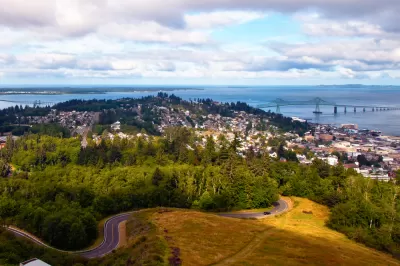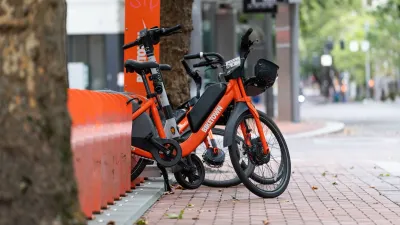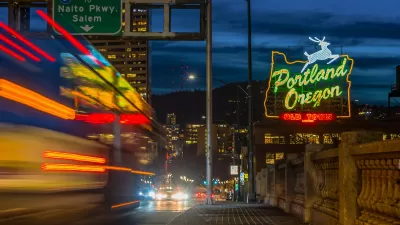Dr. Robert Young of UT-Austin guest blogs about his work on the challenges of promoting sustainable development in peripheral areas of Oregon.

Guest Blogger: Robert Young
My article, "The Oregon Way: Planning a sustainable economy in the American West," began from observations made while walking my dog. Having recently moved to Oregon, I was excited by the prospect of living in the purported "sustainability capital" of the planet (according to its press clippings). In contrast, while walking in my neighborhood—and later, while traveling around the state—what I was seeing (outside of a few gentrified neighborhoods) were poorly built and maintained houses, numerous working poor on the edge, and towns without any solid economic base.
This got me thinking. Oregon certainly didn't lack for indigenous raw materials or talented people seeking to enjoy the state’s ecological beauty. It also had a marked reputation for "green" living and sustainable economic development policies that reached back to the seventies. So why, as my father would say, were so many of the state's residents and towns unable to get up on their own feet? Although at the cutting edge of the sustainability discourse and considered one of the hippest places to relocate, Oregon looked more like an underdeveloped, semi-peripheral country than the beacon of New West prosperity.

To explore this question I began looking into theories of underdevelopment, including classics of the early 20th century, Latin American theorists from 1930-1970, and the work of Harold Innis, a leading Canadian economist of the early-mid 20th century. I then explored Oregon’s economic development policies and state and federal statistics from World War II to the present. The theory, policy, and numbers began to detail a very different picture of Oregon than its boosters represent. In short they reflect, as some underdevelopment theorists note, that countries in the global core have their own internal peripheries (or semi-peripheries) experiencing underdevelopment in relation to the center. At a disadvantage in terms of capital formation, skilled labor, and real economic diversification, they are subject to severe whiplash of boom-bust cycles that make sustained economic development and independence difficult at best. This seemed to accurately reflect the state's reality.
In addition to detailing Oregon's experience in this regard, I also explored the viability of "green" economic development as a strategy to break these boom-bust cycles and set the state on a new, more stable and self-reliant path. What is intriguing to me about this article is its potential to open up a different type of discussion about local and regional economic development in the United States (and perhaps even other core countries). If we begin to look at these areas as internal peripheries and semi-peripheries experiencing structural, long-term, uneven development we may find a much stronger set of theoretical and on-the-ground tools with which to promote the revitalization and redevelopment of these areas.

I believe this approach can have real value in analyzing the issues facing many different parts of the United States. I currently live in Austin, Texas, another "cutting edge," fast growing city favored by the press and people looking to relocate. Yet outside of the "live music capital of the world," Texas cities and towns have been subject to similar boom-bust cycles tied to global energy prices. Although both Texas and Oregon have boasted of diversification in their economies, the experience of much of the population in each of these states (and many others) brings the efficacy of such diversification into critical question.
Planners need to start asking whether “green” economic development can break the boom-bust cycles that leave America's internal peripheries and semi-peripheries underdeveloped. Although knowledge about the impact of sustainable development on addressing structural problems faced by rural ares is limited, my work shows promise for strategies that are strongly rooted in place, people, and ecology.
Dr. Robert Young, Assistant Professor of Planning, University of Texas at Austin

Alabama: Trump Terminates Settlements for Black Communities Harmed By Raw Sewage
Trump deemed the landmark civil rights agreement “illegal DEI and environmental justice policy.”

Planetizen Federal Action Tracker
A weekly monitor of how Trump’s orders and actions are impacting planners and planning in America.

The 120 Year Old Tiny Home Villages That Sheltered San Francisco’s Earthquake Refugees
More than a century ago, San Francisco mobilized to house thousands of residents displaced by the 1906 earthquake. Could their strategy offer a model for the present?

Ken Jennings Launches Transit Web Series
The Jeopardy champ wants you to ride public transit.

BLM To Rescind Public Lands Rule
The change will downgrade conservation, once again putting federal land at risk for mining and other extractive uses.

Indy Neighborhood Group Builds Temporary Multi-Use Path
Community members, aided in part by funding from the city, repurposed a vehicle lane to create a protected bike and pedestrian path for the summer season.
Urban Design for Planners 1: Software Tools
This six-course series explores essential urban design concepts using open source software and equips planners with the tools they need to participate fully in the urban design process.
Planning for Universal Design
Learn the tools for implementing Universal Design in planning regulations.
Clanton & Associates, Inc.
Jessamine County Fiscal Court
Institute for Housing and Urban Development Studies (IHS)
City of Grandview
Harvard GSD Executive Education
Toledo-Lucas County Plan Commissions
Salt Lake City
NYU Wagner Graduate School of Public Service






























